Beginner's Guide to a Jack Russell Terrier Trial
This guide covers entering your terrier at a trial, and participating in Conformation, Racing and Go-to-ground.

This is a beginner's guide to surviving a JRTCA sanctioned terrier trial. This guide covers entering your terrier at a trial, and participating in Conformation, Racing and Go-to-ground.
Entering Events at a Terrier Trial
- If you do not have a trial flyer, please call the contact person for the trial you want to attend (see Trial Schedule).
- Please read the entire trial flyer before entering. Please read the current Sanctioned Trial Rule Book.
- Normally, you must pre-enter the racing division if you plan to participate. Post entries are usually accepted in the other divisions, sometimes at an additional fee. It is appreciated by the trial committee if you pre-enter as much as possible.
- Write legibly the required information on the trial entry form (class number, terrier name, height, age). It is your responsibility to insure that you have entered the correct class. Please pay close attention to the requirements to enter a class (i.e., there may be restrictions on age, sex, height, and coat type).
- Be sure to read and sign the waiver.
- Send in copies of any necessary paperwork (i.e., JRTCA Membership Card, Natural Hunting Certificate, Trial Certificate).
- Send in your entry form with the appropriate entry fees.
- You must send in your entries prior to the entry deadline.
- Read and understand the JRTCA rules governing the running of sanctioned events before arriving at the trial site.
- When you arrive at the trial site, you can pick up your entry packet at the Trial Secretary's table. It's a good idea to bring your checkbook just in case you need to add a class or if you didn't add up your fees correctly. Be sure to bring any paperwork needed for class entry if you did not send a copy with your pre-entry.
- Please park with consideration for your fellow exhibitors. Some trials offer ringside parking. Don't park there if you have not paid your fee.
- Keep your terriers leashed or crated at all times except when they are required to perform off-lead in competition.
- Please, no stake-outs or liberty leashes.
- Always clean up after your terriers (at the trial site and at the hotel of you stay overnight).
- Be on time for your classes or have the courtesy to scratch classes with the trial secretary as soon as you know you will not be entering the class.
- Any problems or complaints should be brought to the trial chairpersons attention.
Conformation
- Please read and understand the Rules of Conformation before entering this event.
- Recommended Equipment: Show Lead, Bait, Exhibitor Number
- Prior to entering the conformation ring, you should walk your dog to allow him to relieve himself and to loosen him up (and you too!)
- Take the correct card from the Trial Packet (there will be a large number on one side and the dog's name on the other), and place it on your upper left arm (so the ring steward can see it when you enter the ring).
- Put some treats or a squeaky toy (please note: excessive use of squeaky or fur-like baiting devices by exhibitors is prohibited and may result in the exhibitor being dismissed from the class) in your pocket. This can be used to keep your dogs attention while in the ring (very important).
- Enter the ring when your class it called. It's probably best to follow someone else so you can watch them with the judge before it is your turn.
- Normally you will walk your terrier counterclockwise around the ring with the rest of the exhibitors. Always keep your terrier on the side facing the judge (usually your left side). Attend to keep the terrier's head up (some will want to keep their head down like they are sniffing a trail).
- After a lap or two (it will seem like forever), the judge will indicate that all the exhibitors should stop. At this point, the judge will begin to work and judge each dog in turn.
- Make sure there is adequate space between your terrier and the ones on either side.
- Keep your attention on what the judge is doing. When the judge is busy, relax your terrier. When the judge is at the end of the individual examination, get your dog's attention and make sure he's standing alertly.
- When it is your turn, you will normally walk you terrier up to the judge and stop. The judge will want to look at your terrier's teeth (to check the bite - see breed standard). If your terrier is overly shy or aggressive, you may have to show the teeth to the judge. Pull back the top and bottom lips so that the judge can see the teeth in the front.
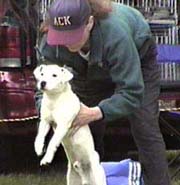 Next the judge will usually "span" the chest of your terrier. This is an important part of the judging process. The judge will place their hands behind the terrier's elbows and measure the size and shape of the terrier's chest. It should be no larger than the size an average man's hands and be springy and flexible. The judge may also check a few other characteristics (i.e., how the coat feels, balance, the flexibility of the terrier, etc).
Next the judge will usually "span" the chest of your terrier. This is an important part of the judging process. The judge will place their hands behind the terrier's elbows and measure the size and shape of the terrier's chest. It should be no larger than the size an average man's hands and be springy and flexible. The judge may also check a few other characteristics (i.e., how the coat feels, balance, the flexibility of the terrier, etc).- The judge will then want you to walk your terrier to the end of the ring and then return. Do not run. Walk in a straight line at a speed where your terrier will walk the best for the judge (this speed will depend on the individual terrier). The judge is looking to see how the terrier "moves" during this phase. Set your sights on where you want to go and walk there, briskly. Don't have the leash strung up tightly.
- Once you return to the judge, have your terrier stand at attention for one last good look for the judge. You are not allowed to touch your terrier at this point (i.e., no stacking).
- Once the judge is done with your terrier, return to your place in line. You can relax your terrier again, but keep an eye on the judge as he/she works the rest of the class.
- Once the judge completes reviewing each individual terrier, the final phase of the class begins. The judge will either walk back and forth along the line of exhibitors or have all the exhibitors walk their dogs around the ring.
- The judge will begin to point at dogs. If you are pointed at, move to the center of the ring in the order you were pointed at. Have your terrier stand at attention. It's not over yet. Once the judge pulls six terriers, the remaining exhibitors/dogs are excused from the class. If you are part of this group, move to the exit.
- The judge may move dogs from one position to another at this point. The judge may also have two places walk together from their position in line to the end of the ring and back. Walk in tandem with the other exhibitor so the judge can see how the terriers look side by side.
- Once the judge has decided the final order of finish, a ribbon will be handed out to each exhibitor. Blue for first, red for second, yellow for third, white for fourth, pink for fifth, and green for sixth.
- Be a good sport and congratulate those who beat you. If you're a winner, win with dignity.
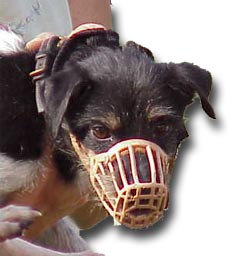
Racing
- Please read and understand the Rules of Racing before entering this event. Racing usually MUST be pre-entered at trials. Post entries "may" be allowed to fill heats. It is a fast paced, lively event. It may help to watch at your first trial, and practice at home with your terrier to teach him to chase a lure and be comfortable with the equipment.
- Recommended Equipment: Strong Lead, Basket or Softie Muzzle
- If your terrier is close to being 12 1/2" tall (see Measuring the Height of your Terrier), we recommend the you get an official JRTCA Height Card for your terrier.
- Review the posted heat sheets prior to racing. It's helpful to write down the class number, heat number, dog name, and collar color. It's also helpful to check and see how many heats there are for your class (can range from only one up to 12).
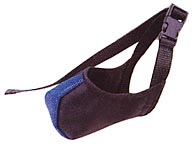 Your terrier must have a muzzle in order to race at a sanctioned trial. Let your terrier play in it at home and get comfortable wearing a muzzle and that it fits properly. Make sure you have it with you when you get set to race.
Your terrier must have a muzzle in order to race at a sanctioned trial. Let your terrier play in it at home and get comfortable wearing a muzzle and that it fits properly. Make sure you have it with you when you get set to race.- Please be ready to run when your class is called. Racing is a fast paced event and it is easy to miss your class.
- A class may be divided into several levels (heat, quarter-final, semi-final, final) depending upon the number of dogs in the class. If there are six or less dogs in the class, then you will be running in the final.
- When your class and heat is called, move to the beginning of the race course and identify yourself (you do not need to identify yourself by dog number like in the conformation ring). You will be given a colored collar (pre-assigned from the posted heat sheets). Put the colored collar on your terrier and have him muzzled before entering the start area. Sometimes terriers can be wild in the commotion, don't hesitate to ask for help.
- Your box position (1 through 6) is usually determined by flipping over a domino, poker chip or designated colors. Please move to the corresponding position in the paddock area.
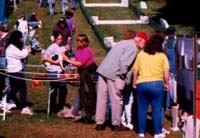 Place your dog in the starting box when told to do so by the starter. Make sure you have removed the leash and dogs regular prior to placing your terrier in the box. Also, make sure the terrier's muzzle and colored colar are still on.
Place your dog in the starting box when told to do so by the starter. Make sure you have removed the leash and dogs regular prior to placing your terrier in the box. Also, make sure the terrier's muzzle and colored colar are still on.
- Once your dog is in the starting box, proceed quickly to the end of the race course.
- You may yell encouragement to your terrier. Be aware that this may have the opposite effect on your terrier (i.e., distraction).
- Remember, the order of finish is determined when the dogs cross a line at the BACK of the haybales as they enter the catch pen - this is not necessarily the order they enter the hole!!
- Once the race is complete, wait for the catcher to hand your dog to you. Please wait for them to verify the results of the race before you reach for your dog.
- Depending on the number of heats, either the top two or three (usually three) dogs will return to run in the next round. Make sure you know if you are to return for the next round. Pay attention when your terrier's name is called. There's nothing worse than winning your heat and then missing a semi-final.
- If your terrier places first in its flat or hurdle class, and ran in both the flat and hurdle classes, it is eligible to run in a Championship race. The Puppy Championships are usually run after the Puppy hurdle races are complete (and before the adult hurdle races). The Adult/Veteran Championships are usually run after the last regular hurdle race. Please be ready to run you terrier.
- If your terrier starts a fight, he/she may be disqualified from racing for the rest of the day. If a fight occurs that interrupts the flow of a race, that race can be re-run at the discretion of the racing judge.
Go-to-Ground
- Please read and understand the Rules of Go-to-Ground before entering this event.
- Recommended Equipment: Strong Lead, GTG Sheet
- The wait at the Go-to-ground can be quite long. Please plan your schedule accordingly.
- 4. You will be given a colored sheet in your registration packet for the GTG class you entered. Make sure you bring your GTG sheet with you when you are ready to run your terrier though the GTG.
- You can normally enter the GTG at any time during the day (there is a several hour window of opportunity). It is up to you to schedule your time so as to not conflict with conformation (if you are entered in that event). Please inform the Paddock steward if you have scratched your terrier from this event (so they don't wait for you).
- You are not allowed to "school" (i.e., practice) at the actual GTG prior to entering the competition.
- Give your GTG sheet to the steward.
- Release your terrier when the judge says GO. All four of the terriers feet must be on the ground behind the line when you release him.
- You may shout encouragements to your terrier during this event.
- Do not block the entrance to the tunnel with your legs/feet.
- Do not proceed to the end of the GTG until the judge tells you to.
- The GTG judge will time the terrier from the moment it is released until it begins to "mark" the quarry (i.e., bark, whine, scratch, etc). Depending upon the class entered (novice, open, championship), the terrier must mark the quarry for a predetermined period of time (usually 30 seconds or a minute).
- Collect your sheet from the judge. Your sheet will indicate whether terrier passed or failed the test. It may also have a time (in seconds) that it took for your terrier to reach and begin to mark. Please note that the time does not count if your terrier does not pass. Reasons for failure can be:
- Terrier leaves earth in a class where this is not allowed
- Terrier does not mark for the required length of time
- Terrier does not mark at all.
- Terrier refuses to enter the tunnel.
- 14. If you pass Novice GTG, you may move up to the next level (Open) by paying the entry fee. You will need to get a GTG sheet for the Open Class. Puppy entries earning a score of 100% in the Open Class at the trial may enter the Puppy Championship class at the next trial and until they turn one year old. They may apply for a certificate when they are registered or recorded. Adults may not enter their Championship Certificate class until they have an actual, issued certificate.
- The results of the GTG are announced near the end of the trial.
- Don't be discouraged if your terrier doesn't even go in the tunnel. This happens a lot to first time GTG dogs. Attend fun days or work with the judge or experienced owner after the trial to learn ways to teach your terrier about GTG.
Survival Kit
This section details a Jack Russell Terrier Trial Survival Kit.
- Tent - definitely a must at a terrier trial. It helps keep your dogs cool (it'll keep you cool also). You might also have the bad luck of attending a trial in the rain so make sure the tent is water proof.
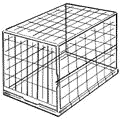 Crate - terriers are not allowed to run free at a trial so you should either plan on keeping on terrier on a leash all day or bring a crate (metal or veri-kennel).
Crate - terriers are not allowed to run free at a trial so you should either plan on keeping on terrier on a leash all day or bring a crate (metal or veri-kennel).- Rabies Certificate - always carry a copy of your dog's rabies certificate with you. You never know if your dog might bite someone (by accident or on purpose). You'll be required to show a copy of the rabies certificate to prove your JR is rabies-free.
- Crate Fan - can be attached to crate to keep your terrier cool during summer trials.
- Exercise Pen (Ex-Pen) - allows you to give your terrier a break from the crate during the trial. Should be covered and secured to the ground for safety.
- Food - many trials will have a place to purchase lunch but it always pays to be prepared.
- Trial Flyer - this will allow you to determine when your terrier needs to be ready to enter an event.
- Water - for your terriers. They needs lots of water for those trials held during the summer. Not all trial sites have running water.
- Leashes - travel with several different types of leashes. You might need leashes for conformation (small, lightweight, short), agility (lightweight, 4 foot), racing/Go-to-ground (strong, padded), and just for walking (flex lead, 25 feet).v
- Chairs - most trials can last 8 hours or more. You need to sit down sometime!
 Racing Equipment - a basket or softie muzzle is required for all terriers that race - to protect them and the catchers.
Racing Equipment - a basket or softie muzzle is required for all terriers that race - to protect them and the catchers.- First Aid Kit - to treat minor injuries
- All Weather gear - Rain coat and boots, etc.
- Sunscreen - most trials are outdoors and afford no protection from the sun.
- Cooler - for your favorite beverage
- Truck or Van - to haul this list from trial to trial. No truck or van is large enough once you start to attend multiple terrier trials.
- Height Card - if you race your terrier, you should get a height card. Bring it with you to each trial.
- Membership Card - sanctioned JRTCA trials are open to members only.